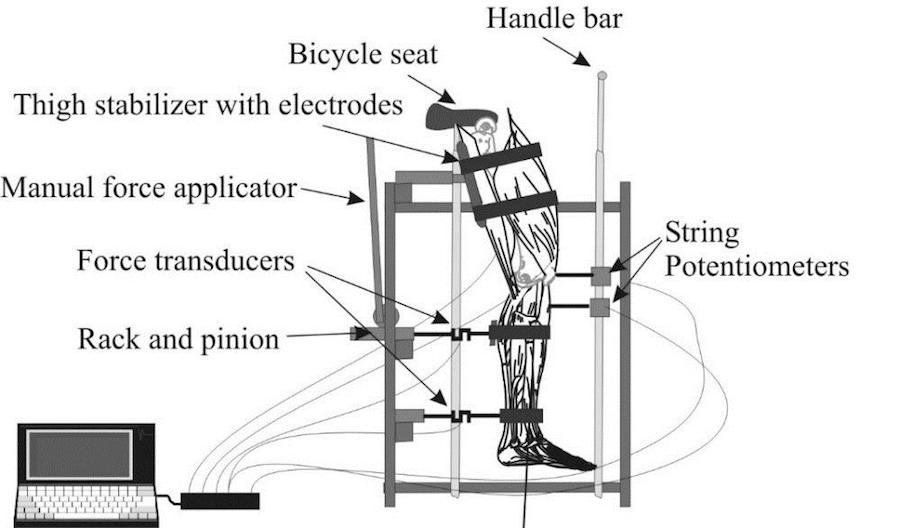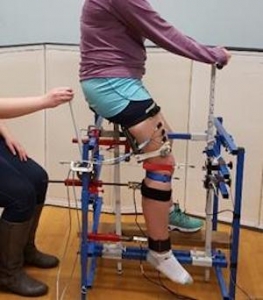
The Human Performance Lab at Hickey Gym researches musculoskeletal structure, applied to minimize risk of injury
The Human Performance Lab (HPL), located in UC Davis’ Hickey Gym, aims to understand the mechanisms of the human body in order to improve both quality of life and physical capability in the limbs, bones and muscles.
David Hawkins, professor in the Department of Neurobiology, Physiology and Behavior and head of the research group, seeks to provide the public with tools to improve their physical activities.
The HPL was originally founded in 1963, and the Hawkins Research Group (HRG) branch at UC Davis has performed some incredible research.
“The research done in the HPL has direct clinical applications, and I was excited to pursue research efforts that could potentially decrease injury incidence among active populations in the future,” said Erica Stevens, alumni class of 2016 and former student-researcher in HPL.
Current research is focused on knee ligament ruptures resulting from previous traumas and how small build-ups of damage over a long period of time may be the cause of these ruptures.
Hawkins has proposed a knee-laxity test, which detects small damages in ligaments before rupture and reflects changes in ligaments’ mechanical properties. According to Hawkins, the data from the tests supports the hypothesis that micro-damages can be detected prior to ligament rupture.

There are a variety of students researching in the HPL under Professor Hawkins, including alumni Erica Stevens who had her own specified project which studied a possible correlation between noncontact anterior cruciate ligament (ACL) injuries and Patellar Tendon Insertion (PTTI) angles among UC Davis athletes.
The ACL is a major tissue that connects the thigh bone to the shin bone at the knee and helps stabilize the knee joint. The PTTI angle is the angle at which the patellar tendon, the tissue connecting the kneecap to the shin, inserts into the tibial tuberosity located at the top of the lower leg.
“We hypothesized that a greater PTTI angle would lead to increased anterior translation — [the kinetics of knee movement] — of the tibia [a bone in the lower leg], subsequently leading to increased ACL force,” Stevens said.
In order to determine the PTTI angle directly from the athletes, 10 plastic markers were placed on the lateral surfaces of their legs. Each leg was photographed in full extension and then digitized via MaxTRAQ, a motion analysis software.
The coordinates were later inputted into Microsoft Excel to finally determine the PTTI angle of each knee.
The data collected from this pilot study supported the hypothesis that there was a correlation between ACL injuries and the PTTI angle. However, due to the small sample size, the hypothesis must be expanded by a larger research group.
“It could prompt physicians, physical therapists and/or coaches in the future to screen for athletes with larger PTTI angles and provide them with preventative strengthening exercises to decrease their relative risk for noncontact ACL injuries,” Stevens said.
Another student working under Professor Hawkins is Shonit Nair Sharma, third-year biomedical engineering major, who has his own project analyzing acceleration data from runners to identify those at risk for injury.
Originally researching under the Mathematics Department on an exercise biology lab, Sharma became interested in the Human Performance Lab after reaching out to Professor Hawkins as a collaborative reference.
“My research project involved writing a MATLAB code to process and analyze workbooks of data collected during a study of collegiate distance runners,” Sharma said.
MATLAB is software that is used for technical computing, allowing the implementation of algorithms, plotting of functional data and easy visualization of complex problems and their solutions.
The data was collected from UC Davis runners via physical monitors. The acceleration data for the left side of the hip was often lower due to human error because the device was worn specifically on the right hip. Much of this project’s research was centered around solving this problem.
“It was necessary that the [MATLAB] code accounted for the discrepancy between left and right hip acceleration values, for the physical activity monitors worn by the athletes were unable to do so,” Sharma said.
The data was then analyzed to identify runners who were at risk for injury.
Past research projects include muscle-tendon lengthening, in which muscle performance was measured after being lengthened by one of two alternative procedures. Another research project studied athletes’ athletic performances while doing rowing motions on dry land, stimulating water training.
The quantitative information of the athletes’ kinematics and forms provided great feedback for both the coach and the athletes to improve their respective performances. This information included different techniques ability to change power output of the muscles and identify how techniques change with muscle fatigue.
HPL has investigated many effective studies, such as The Backpack Load Carriage Project, which evaluated the productivity of hip belts for reducing skin pressure and muscle exertion while one wears a backpack.
There is seemingly no limit to the creativity of the human-performance studies under the HPL.
“My research group is also exploring wearable technology to provide remote health-monitoring and physical activity prescription,” Hawkins said.
Collaborations with colleagues from different departments is common, especially when human and animal models are used.
“I have collaborated with colleagues in the Veterinary Medical School to conduct similar types of human and horse anatomical modeling and movement simulations to explore potential mechanisms of injury,” Hawkins said.
Other projects include partnering with the College of Biological Sciences to explore signaling pathways that contribute to skeletal muscle hypertrophy, as well as with the [UC Davis] Medical School to investigate the healing response following various muscle-tendon release techniques.
“Professor Hawkins encourages all of his students to critically question the information they’re presented with […] so the last two years of my undergraduate career really helped me to become the inquisitive student I am today,” Stevens said.
Written by: Shivani Kamal — science@theaggie.org



